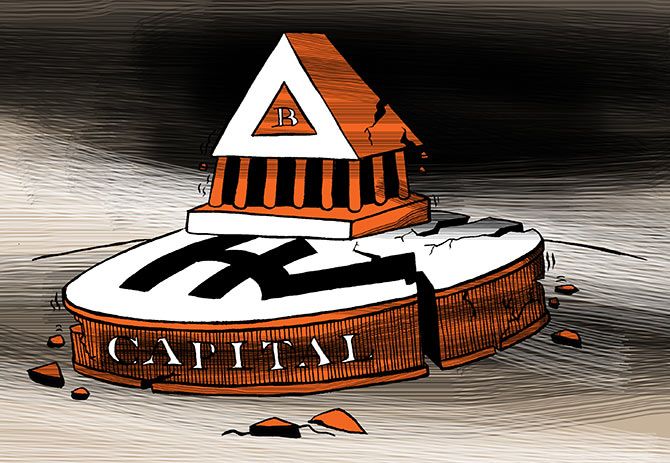 | « Back to article | Print this article |
As far as the Jalan committee recommendation is concerned, the transfer of Rs 52,637 crore is far lower than what analysts were expecting.
In fact, the RBI’s capital position would still be one of the strongest in the world.
Anup Roy answers some frequently asked questions.
Illustration: Uttam Ghosh/Rediff.com

What has happened?
The RBI board decided to transfer Rs 123,414 crore of its surplus, generated in fiscal year 2018-19 (FY19).
The RBI follows a July-June year.
The central bank has already given the government Rs 28,000 crore as interim dividend.
The Bimal Jalan Committee on Economic Capital Framework (ECF) has suggested an additional transfer of Rs 52,637 crore of excess provisions.
The government will immediately get a net of Rs 148,051 crore.
Does RBI transfer its surplus every year?
Yes, it does.
According to the suggestions of a committee headed by Y H Malegam, the RBI has enough capital and should transfer the entire amount to the government as surplus.
In the past five years, the RBI did not boost its reserves as such, but transferred the money to the government.
Last year, it transferred Rs 50,000 crore.
How did the RBI earn so much in a slowing global economy?
A significant portion of this earning is interest generated from the secondary market bond purchases by the RBI.
It bought bonds worth Rs 3 trillion to boost liquidity in the system.
So to that extent, the government actually gets less than Rs 1.48 trillion.
Still, it is a significant figure.
What does the government do with the money?
It is up to the government. About Rs 70,000 crore can go for bank recapitalisation.
It can also spend some of the money for stimulus measures.
Whatever it is for, the bond market is happy that the government need not float extra bonds for the stimulus and bank recapitalisation.
Does the transfer weaken the RBI?
Not exactly, but it does chip away some of the financial resilience of the central bank.
The dividend transfer as such is a moot point, because whatever the RBI earns it transfers.
In 2018-19, they must have earned more and so the transfer is more.
However, concerns could arise if the transfer has been done by changing the accounting.
As far as the Jalan committee recommendation is concerned, the transfer of Rs 52,637 crore is far lower than what analysts were expecting.
In fact, the RBI’s capital position would still be one of the strongest in the world.
What did the Jalan panel recommended exactly?
The RBI should be its economic capital, which is its contingency fund, plus revaluation reserves, at 20-24.5 per cent of the balance sheet.
After the transfer, this will be 23.3 per cent.
Specifically, the panel said the contingency fund, which it called “realised equity”, should never be 5.5 per cent to 6.5 per cent.
Now, this realised fund is 6.8 per cent.
The RBI board accepted to keep the fund at 5.5 per cent of the balance sheet, freeing up money for transfer.
Had they accepted 6.5 per cent as the level for “realised equity”, the transfer would have been Rs 11,608 crore.
How much are the contingency fund and revaluation reserves?
As of June 2018, the contingency fund is Rs 2.3 trillion, and revaluation reserves are Rs 6.9 trillion.
Why was money not transferred from the revaluation reserve?
This is because the RBI cannot transfer what it has not earned.
This money rose from revaluation of its investments. It is a nominal reserve.
On the other hand, contingency fund is a real reserve that the RBI built up from its earnings.
So, this is digging into past reserves of the central bank, which former RBI governor D Subbarao and deputy governor Viral Acharya termed as “raiding” the balance sheet of the RBI.
How will the transfer take place?
It is a book entry really.
There is no hard cash getting carried to Delhi from Mumbai.
The RBI is the bank of the government and manages its cash anyway.
So the amount is debited from the RBI’s books and gets credited to the government’s books maintained with the RBI.
But like any book entry, the RBI will have to do a careful balancing act.
That might have implications.
What implications?
Reserves are a liability side item.
After the transfer, the RBI’s liability side shrinks, but the asset side remains intact.
So, the RBI can sell bonds from its asset side, or some of its other assets to shrink the balance sheet.
But that will suck out liquidity from the system, something that the RBI has rectified after a lot of struggle in the recent past.
Instead, it can print more currencies and increase the liability side.
So, the currency in circulation increases.
What happens if currency in circulation increases?
If the currency in circulation is more than the demand, then the currency loses its value.
That means more inflation, and as the rupee depreciates, import cost also rises and that causes additional inflation.
At a time when the RBI is officially mandated to contain inflation within a specific range, increased currency in circulation works against that goal.
Surely, the RBI will have to contain it at some point.